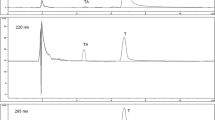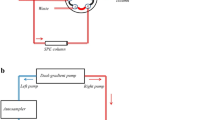Abstract
An improved extraction and HPLC method for the simultaneous extraction and quantitation of retinol, α-tocopherol, α-tocotrienol, and β-carotene was developed to analyze commercial whole/semi-skim/skim samples of raw/pasteurized/UHT milk in transparent plastic/glass bottles and Tetra Brik™ containers. The sample preparation method required prior saponification at 40 °C for 15 min followed by n-hexane extraction. An isocratic acetonitrile/methanol (65:35 v/v) mobile phase, C18 analytical column, and UV detector were chosen for HPLC quantification. The liposoluble vitamin content in raw, pasteurized conventional/organic, and UHT milk ranged 0.055–5.540 (retinol), 0.135–1.410 (α-tocopherol), and 0.040–0.850 mg/L (β-carotene). No significant differences (p > 0.05) were observed on losses of retinol, α-tocopherol, and β-carotene content in UHT whole milk after 5 days at 4 °C in the dark. After 14 days at 4 °C in the dark, the contents of retinol, α-tocopherol, and β-carotene remained higher in milk with higher fat content and were higher in unopened containers. In UHT whole milk, samples containing 0.02 % NaN3, retinol (33 %), and α-tocopherol (11 %) but not β-carotene (2 %) decreased significantly (p < 0.05).


Similar content being viewed by others
References
MacGibbon AKH, Taylor MW (2003) Composition and structure of bovine milk lipids. In: Fox PF, McSweeny PLH (eds) Advanced dairy chemistry, lipids, vol 2. Springer, New York, pp 1–35
Herrero C, Granado F, Blanco I, Olmedilla B (2002) Vitamin A and E content in dairy products: their contribution to the recommended dietary allowances (RDA) for elderly people. J Nutr Health Aging 6(1):57–59
Sommer A, West KP (1996) Vitamin A deficiency: health, survival, and vision. Oxford University Press, Oxford
Baldi A, Pinotti L (2008) Lipophilic microconstituents of milk. In: Bösze Z (ed) Bioactive components of milk. Springer, New York, pp 109–128
Miquel E, Alegria A, Barbera R, Farre R, Clemente G (2004) Stability of tocopherols in adapted milk-based infant formulas during storage. Int Dairy J 14:1003–1011
Kamal-Eldin A, Gorgen S, Pettersson J, Lampi AM (2000) Normal-phase high-performance liquid chromatography of tocopherols and tocotrienols—comparison of different chromatographic columns. J Chromatogr A 881:217–227
McDowell LR (2000) Vitamins in animal and human nutrition. Vitamin E, 2nd edn. Iowa State University Academic Press, Ames, IA
Brigelius-Flohe R, Traber MG (1999) Vitamin E: function and metabolism. FASEB J 13:1145–1155
Chavez-Servin JL, Castellote AI, Lopez-Sabater MC (2006) Simultaneous analysis of Vitamins A and E in infant milk-based formulae by normal-phase high-performance liquid chromatography-diode array detection using a short narrow-bore column. J Chromatogr 1122:138–143
Krukovsky V, Whiting F, Loosli JK (1950) Tocopherol, carotenoid and vitamin A content of the milk fat and the resistance of milk to the development of oxidized flavors as influenced by breed and season. J Dairy Sci 33(11):791–796
Kaushik S, Wander R, Leonard S, German B, Traber MG (2001) Removal of fat from cow’s milk decreases the vitamin E contents of the resulting dairy products. Lipids 36:73–78
Agabriel C, Cornu A, Journal C, Sibra C, Grolier P, Martin B (2007) Tanker milk variability according to farm feeding practices: vitamins A and E, carotenoids, color, and terpenoids. J Dairy Sci 90:4884–4896
Kalac P (2011) The effects of silage feeding on some sensory and health attributes of cow’s milk: a review. Food Chem 125:307–317
Ball GFM (1998) Bioactivity and analysis of vitamins in foods. Chapman & Hall, London
Lindmark-Månsson H, Fondéna R, Pettersson HE (2003) Composition of Swedish dairy milk. Int Dairy J 13:409–425
Podda M, Weber C, Traber MG, Packer L (1996) Simultaneous determination of tissue tocopherols, tocotrienols, ubiquinols, and ubiquinones. J Lipid Res 37:893–901
Bernal J, Mendiola JA, Ibanez E, Cifuentes A (2011) Advanced analysis of nutraceuticals. J Pharm Biomed Anal 55:758–774
Liyanage C, Hettiarachchi M, Mangalajeewa P, Malawipathirana S (2008) Adequacy of vitamin A and fat in the breast milk of lactating women in south Sri Lanka. Public Health Nutr 11(7):747–750
Plozza T, Trenerry VC, Caridi D (2012) The simultaneous determination of vitamins A, E and β-carotene in bovine milk by high performance liquid chromatography-ion trap mass spectrometry (HPLC-MS). Food Chem 134(1):559–563. doi:10.1016/j.foodchem.2012.02.121
Szlagatys-Sidorkiewicz A, Zagierski M, Jankowska A, Łuczak G, Macur K, Bączek T, Korzon M, Krzykowski G, Martysiak-Żurowska D, Kamińska B (2012) Longitudinal study of vitamins A, E and lipid oxidative damage in human milk throughout lactation. Early Hum Dev 88(6):421–424
Turner T, Burri BJ (2012) Rapid Isocratic HPLC method and sample extraction procedures for measuring carotenoid, retinoid, and tocopherol concentrations in human blood and breast milk for intervention studies. Chromatographia 75(5–6):241–252. doi:10.1007/s10337-012-2193-9
Moyssiadi T, Badeka A, Kondyli E, Vakirtzi T, Savvaidis I, Kontominas MG (2004) Effect of light transmittance and oxygen permeability of various packaging materials on keeping quality of low fat pasteurized milk: chemical and sensorial aspects. Int Dairy J 14:429–436
Zygoura P, Moyssiadi T, Badeka A, Kondyli E, Savvaidis I, Kontominas MG (2004) Shelf life of whole pasteurized milk in Greece: effect of packaging material. Food Chem 87:1–9
Ellis KA, Monteiro A, Innocent GT, Grove-White D, Cripps P, McLean WG (2007) Investigation of the vitamins A and E and b-carotene content in milk from UK organic and conventional dairy farms. J Dairy Res 74:484–491
Escrivá A, Esteve MJ, Farré R, Frígola A (2002) Determination of liposoluble vitamins in cooked meals, milk and milk products by liquid chromatography. J Chromatogr A 947:313–318
Lee BL, New AL, Ong CN (2003) Simultaneous determination of tocotrienols, tocopherols, retinol, and major carotenoids in human plasma. Clin Chem 49(12):2056–2066
Reische DW, Lillard DA, Eitenmiller RR (2002) Antioxidants. In: Akoh CC, Min DB (eds) Food lipids: chemistry, nutrition and biotechnology, chap 15, Marcel Dekker Inc., New York, pp 507–534
Rodas-Mendoza B, Morera-Pons S, Castellote-Bargalló AI, López-Sabater MC (2003) Rapid determination by reversed-phase high-performance liquid chromatography of vitamins A and E in infant formulas. J Chromatogr A 1018:197–202
Eitenmiller RR, Ye L, Landen WO (2008) Vitamin analysis for the health and food sciences, 2nd edn. CRC Press, Boca Raton, FL
Bognar A (1986) Determination of vitamin A in food using high-pressure liquid chromatography. Results of a collaborative study of the vitamin analysis working group following the LMBG paragraph 35. Zeitschrift für Lebensmittel-Untersuchung und -Forschung A (Berlin) 182(6):492–497
Albalá-Hurtado S, Novella-Rodríguez S, Veciana-Nogués MT, Mariné-Font A (1997) Determination of vitamins A and E in infant milk formulae by high-performance liquid chromatography. J Chromatogr A 778:243–246
Anonymous (1997) Producción y manejo de datos de composición química de alimentos en nutrición. Oficina Regional de la FAO para América Latina y el Caribe, Santiago de Chile
Vial J, Jardy A (1999) Experimental comparison of the different approaches to estimate LOD and LOQ of an HPLC method. Anal Chem 71:2672–2677
Nelis HJCF, De Leenheer AP (1983) Isocratic nonaqueous reversed-phase liquid chromatography of carotenoids. Anal Chem 55(2):270–275
Arnaud J, Fortis I, Blachier S, Kia D, Favier A (1991) Simultaneous determination of retinol, α-tocopherol and β-carotene in serum by isocratic high-performance liquid chromatography. J Chromatogr B Biomed Sci Appl 572(1–2):103–116
Gruszka J, Kruk J (2007) RP-LC for determination of plastochromanol, tocotrienols and tocopherols in plant oils. Chromatographia 66:909–913
Escriva A, Esteve MJ, Farre R, Frigola A (2002) Determination of liposoluble vitamins in cooked meals, milk and milk products by liquid chromatography. J Chromatogr A 947(2):313–318
Gentili A, Caretti F, Bellante S, Ventura S, Canepari S, Curini R (2013) Comprehensive profiling of carotenoids and fat-soluble vitamins in milk from different animal species by LC-DAD-MS/MS hyphenation. J Agric Food Chem 61:1628–1639
Chauveau-Duriot B, Doreau M, Nozière P, Graulet B (2010) Simultaneous quantification of carotenoids, retinol, and tocopherols in forages, bovine plasma, and milk: validation of a novel UPLC method. Anal Bioanal Chem 397:777–790
Stefanov I, Vlaeminck B, Fievez V (2010) A novel procedure for routine milk fat extraction based on dichloromethane. J Food Compos Anal 23:852–855
Stancher B, Zonta F (1983) High-performance liquid chromatography of fat-soluble vitamins: simultaneous quantitative analysis of vitamins D2, D3, and E. Study of percentage recoveries of vitamins from cod liver oil. J Chromatogr A 256:93–100
Karpińska J, Mikołuć B, Motkowski R, Piotrowska-Jastrzębska J (2006) HPLC method for simultaneous determination of retinol, α-tocopherol and coenzyme Q10 in human plasma. J Pharm Biomed Anal 42:232–236
Chandan RC (2007) Milk composition, physical and processing characteristics. In: Hui YH (ed) Handbook of food products manufacturing: health, meat, milk, poultry, seafood, and vegetables, vol 2. Wiley-Interscience, Hoboken, NJ, pp 347–378
Paul AA, Southgate DAT (1985) McCance and Widdowson’s the composition of foods. Biomedical Press, London
Renner E, Schaafsma G, Scott KJ (1989) Micronutrients in milk. In: Renner E (ed) Micronutrients in milk and milk-based food products. Elsevier Science, London, pp 1–70
Ollilainen V, Heinonen M, Linkola E, Varo P, Koivistoinen P (1989) Carotenoids and retinoids in Finnish foods: dairy products and eggs. J Dairy Sci 72:2257–2265
Bergamo P, Fedele E, Iannibelli L, Marzillo G (2003) Fat-soluble vitamin contents and fatty acid composition in organic and conventional Italian dairy products. Food Chem 82(4):625–631
Early R (1998) The technology of dairy products, 2nd edn. Thomson Science, London
Hulshof PJM, Roekel-Jansen T, Bovenkampy P, West CE (2006) Variation in retinol and carotenoid content of milk and milk products in The Netherlands. J Food Compos Anal 19:67–75
Acknowledgments
The authors acknowledge funding from the INCITE program of the Galician Council of Innovation and Industry (Ref. 09TAL019383PR), general support to the research groups of Universities of Vigo and Aveiro provided by the European Regional Development Fund (ERDF/FEDER), Fundação para a Ciência e a Tecnologia (FCT, Portugal), European Union, QREN, FEDER and COMPETE for funding the QOPNA research unit (Project PEst-C/QUI/UI0062/2013), and Formula Grants No. 2011-31200-06041 and 2012-31200-06041 from the USDA National Institute of Food and Agriculture. The authors of this work gratefully acknowledge CAPSA and Santa Mariña de Loureiro for their cooperation on this research.
Conflict of interest
None.
Compliance with Ethics Requirements
This article does not contain any studies with human or animal subjects.
Author information
Authors and Affiliations
Corresponding author
Rights and permissions
About this article
Cite this article
Chotyakul, N., Pateiro-Moure, M., Saraiva, J.A. et al. Simultaneous HPLC–DAD quantification of vitamins A and E content in raw, pasteurized, and UHT cow’s milk and their changes during storage. Eur Food Res Technol 238, 535–547 (2014). https://doi.org/10.1007/s00217-013-2130-7
Received:
Revised:
Accepted:
Published:
Issue Date:
DOI: https://doi.org/10.1007/s00217-013-2130-7




